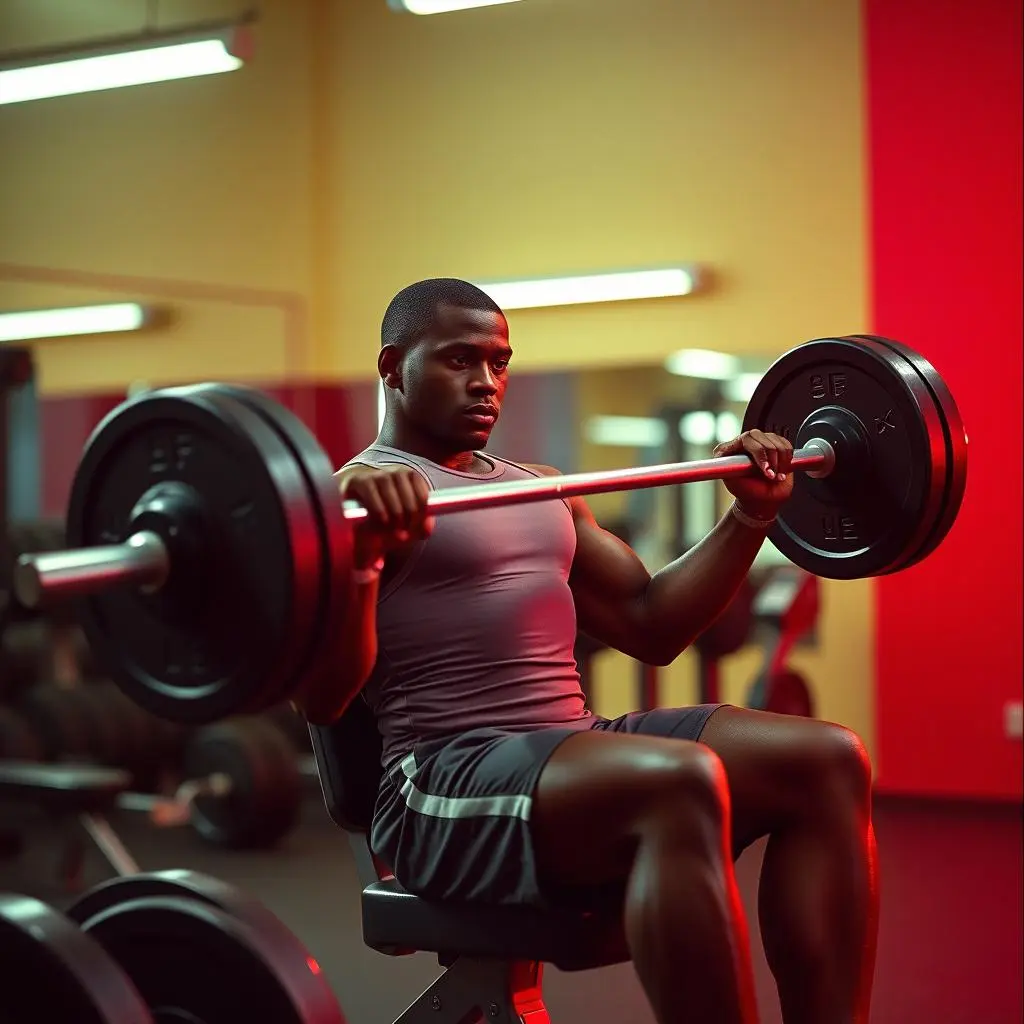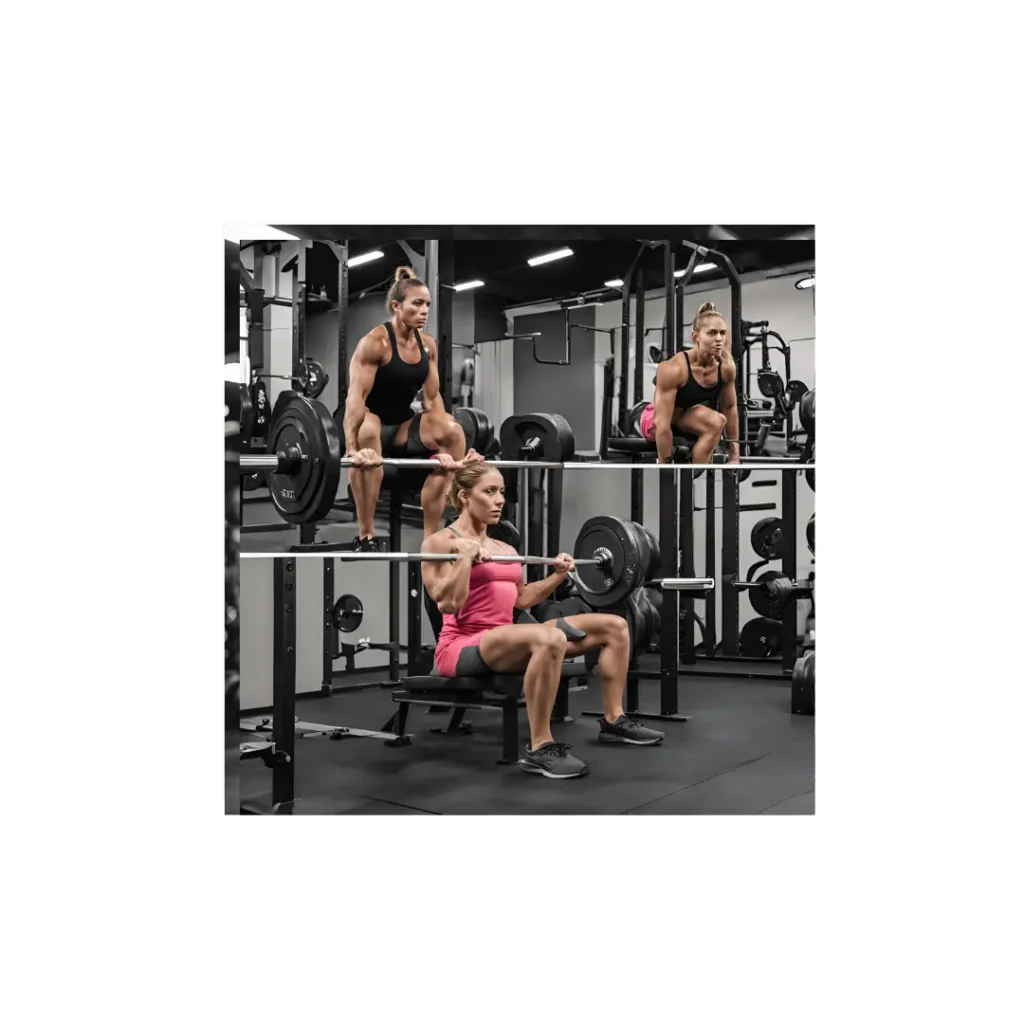Definition and Purpose
The seated barbell curl is a strength training exercise that primarily targets the biceps brachii muscle group. In this exercise, you sit on a bench with your back straight and feet on the ground. You hold a barbell with an underhand grip, palms facing up.
The movement involves bending your elbows to lift the barbell to your shoulders. Then, lower it down in a controlled way. Sitting stabilizes your body. It isolates the biceps and minimizes other muscles’ involvement. This leads to more focused muscle activation.
The purpose of the seated barbell curl is to develop strength, size, and definition in the biceps muscles. It is a basic arm exercise. It is in any arm-focused workout routine. It is in both beginner and advanced training programs. The seated barbell curl targets the biceps. It improves upper body looks and arm strength for movements. It also helps keep the upper body balanced.
Benefits of Seated Barbell Curl

1. The seated barbell curl is great for biceps. It stimulates the biceps a lot. Do this exercise right and often. Use good form and progress. You can expect big gains in bicep size and definition.
2. Isolation and Control: Seating during the exercise helps steady the body. It reduces the chance of using momentum to lift the weight. This isolation of the biceps ensures that they bear the brunt of the work. This leads to better muscle engagement and development.
3. Strength Building: Along with muscle hypertrophy, the seated barbell curl is an effective way to build strength in the biceps. By lifting heavier weights or doing more reps, individuals can push their strength limits and spur more growth.
4. Versatility: This exercise can be adapted to accommodate various fitness levels and goals. You can use lighter weights for high-repetition sets. This focuses on muscle endurance. Or, you can use heavier weights for lower-repetition sets. This targets maximal strength. You can customize the seated barbell curl to match your preferences and objectives.
5. Convenience and Accessibility: You need minimal equipment for the seated barbell curl—a barbell and a bench. This makes it accessible to people training in a gym or at home with a basic setup. Its simplicity and effectiveness make it a staple exercise in any arm training regimen.
Technique and Execution

Proper Set-up
1. Bench Positioning: Sit comfortably on a flat bench with your back straight and feet flat on the floor. Ensure the bench is positioned so that you have enough space to fully extend your arms without hitting any obstacles.
2. Barbell Placement: Place a barbell in front of the bench. Adjust the position of the barbell so that it is within reach while maintaining a slight bend in your elbows when fully extended.
Gripping the Barbell
1. Use an underhand grip to grasp the barbell. Your palms should face upwards. Your hands should be spaced a bit wider than shoulder-width. Your hands should be positioned outside of your thighs.
2. Thumb Placement: Wrap your thumbs around the barbell to secure your grip and prevent the barbell from slipping.
Body Positioning
1. Back Support: Lean back against the bench with your shoulders relaxed and your chest lifted. Maintain a neutral spine throughout the exercise to avoid straining your lower back.
2. Elbow Placement: Keep your elbows close to your sides throughout the movement. Avoid allowing your elbows to flare outwards, as this can put unnecessary stress on your shoulders.
3. Place your feet firmly on the floor. They should be about shoulder-width apart. This will give you stability. Keep your knees bent at a comfortable angle.
Execution of the Curl
1. Initiate the Movement: With your arms fully extended and elbows locked, lift the barbell by flexing your elbows. Keep your wrists straight and maintain tension in your biceps throughout the movement.
2. Curl the barbell towards your shoulders slowly. Focus on squeezing your biceps. Keep your upper arms stationary and avoid swinging the weight or using momentum.
3. Peak Contraction: At the top of the movement, squeeze your biceps for a brief moment to maximize muscle activation.
4. Lower the barbell back slowly to the starting position. Keep control over the descent. Resist the urge to let the weight drop quickly, as this can increase the risk of injury.
Breathing Technique
1. Inhale: Take a deep breath as you lower the barbell towards your thighs, filling your lungs with air.
2. Exhale: Exhale forcefully as you curl the barbell towards your shoulders, expelling air from your lungs. Keep a steady breathing rhythm. Do this to maximize oxygen flow and keep intra-abdominal pressure for stability.
Muscles Targeted
Primary Muscles

The seated barbell curl primarily targets the following muscles:
1. Biceps Brachii: The biceps brachii, commonly known as the biceps, is the primary muscle worked during the seated barbell curl. This muscle is on the front of the upper arm. It flexes the elbow joint, lifting the weight during the curl.
Secondary Muscles
The seated barbell curl isolates the biceps. But, it also uses other muscles to help in the movement.
1. Brachialis: The brachialis is a muscle located underneath the biceps brachii. It plays a significant role in elbow flexion and is activated during the seated barbell curl, especially when using a neutral grip.
2. The brachioradialis is a forearm muscle. It helps flex the elbow and rotate the palm downwards. It is recruited to a lesser extent during the seated barbell curl but still contributes to the overall movement.
3. Forearm Flexors: The muscles of the forearm, including the flexor carpi radialis, flexor carpi ulnaris, and palmaris longus, are activated isometrically to stabilize the wrist and grip the barbell securely throughout the exercise.
4. Deltoids: The anterior (front) deltoids, located at the front of the shoulder, are involved in stabilizing the shoulder joint during the seated barbell curl. While they are not directly targeted by the exercise, they play a supportive role in maintaining proper form and stability.
Common Mistakes and How to Avoid Them

Using Momentum
1. Mistake: Swinging the weight or using momentum to lift the barbell.
2. Using momentum reduces the exercise’s impact. It takes tension off the biceps and raises the injury risk.
3. Avoidance Techniques:
a. Focus on controlled movements throughout the entire range of motion.
b. Use a weight that allows you to maintain proper form without relying on momentum.
c. Concentrate on squeezing the biceps at the top of the movement to maximize muscle activation.
d. Slow down the tempo of the exercise to minimize swinging.
Incorrect Grip
1. Mistake: Gripping the barbell too narrow or too wide.
2. Impact: An incorrect grip can place undue stress on the wrists, elbows, and shoulders, leading to discomfort or injury.
3. Avoidance Techniques:
a. Use a grip that is slightly wider than shoulder-width apart to target the biceps effectively.
b. Ensure that your hands are positioned symmetrically on the barbell, with equal spacing between each hand.
c. Experiment with different grip widths to find the most comfortable and effective grip for your body mechanics.
d. Avoid gripping the barbell too tightly, as this can cause unnecessary tension in the forearms and wrists.
Poor Posture
1. Mistake: Slouching or arching the back, rounding the shoulders, or lifting the chest excessively.
2. Impact: Poor posture can compromise the stability of the spine and increase the risk of injury to the lower back and shoulders.
3. Avoidance Techniques:
a. Sit upright with your back straight throughout the exercise.
b. Keep your shoulders pulled back and down, away from your ears, to maintain proper shoulder alignment.
c. Engage your core muscles to stabilize your spine and support proper posture.
d. Avoid hyperextending the lower back or overarching the upper back by maintaining a natural curvature in the spine.
e. If necessary, reduce the weight being lifted to ensure that you can maintain proper posture throughout the exercise.
Variations and Modifications
Alternating Seated Barbell Curl

1. In the seated barbell curl variation, you curl each arm one at a time.
2. Execution: Start with a barbell in both hands, palms facing upwards, and arms fully extended. Curl one arm towards your shoulder while keeping the other arm extended. Alternate between arms in a controlled manner.
3. This variation has benefits. It helps fix strength imbalances between the left and right arms. It also challenges core stability more. And, it lets you focus more on each arm.
Wide Grip Seated Barbell Curl
1. The wide grip seated barbell curl involves gripping the barbell. You do so with hands spaced wider than shoulder-width apart.
2. Execution: Sit on a bench with your back straight and grip the barbell with an overhand grip, hands placed wider than shoulder-width apart. Perform the curling motion as usual, focusing on keeping the elbows close to the body.
3. The wider grip has benefits. It puts more emphasis on the outer portion of the biceps. It targets the long head of the biceps brachii. It also works the forearms and shoulders more. This provides a different stimulus for muscle growth.
Preacher Bench Seated Barbell Curl
1. Description: The preacher bench seated barbell curl involves performing the exercise on a preacher bench, which provides support for the arms and isolates the biceps.
2. Execution: Sit on the preacher bench with your chest pressed against the pad and your arms fully extended over the bench. Grip the barbell with an underhand grip and perform the curling motion, focusing on maintaining control and tension in the biceps.
3. Benefits: The preacher bench variation reduces the involvement of the shoulder and back muscles, allowing for greater isolation of the biceps. It also helps to eliminate cheating or swinging motions, making it an effective exercise for strict biceps training. Additionally, the preacher bench can help reduce strain on the wrists and elbows by providing support throughout the movement.
Programming and Training Tips
Reps and Sets

1. Reps and Sets: For muscle hypertrophy (growth), aim for 3-4 sets of 8-12 repetitions per set. This rep range helps stimulate muscle growth while maintaining proper form and technique.
2. Variation: To target different aspects of muscle development, you can incorporate different rep ranges. For example, lower reps (4-6) with heavier weights can focus on strength development, while higher reps (12-15) with lighter weights can emphasize muscle endurance.
Frequency
1. Frequency: Include the seated barbell curl in your arm-focused workouts, which can typically be performed 1-2 times per week.
2. Rest Days: Allow at least 48 hours of rest between workouts targeting the same muscle group to ensure adequate recovery and muscle growth.
3. Listen to Your Body: Pay attention to how your muscles respond to training and adjust frequency accordingly. If you experience excessive soreness or fatigue, consider reducing the frequency of seated barbell curl sessions.
Progression
1. Progressive Overload: Continuously challenge your muscles by progressively increasing the weight lifted, reps performed, or sets completed over time.
2. Incremental Increases: Gradually increase the weight lifted by small increments (e.g., 2.5-5 lbs) as you get stronger. This gradual progression helps prevent injury and allows for sustainable muscle growth.
3. Tracking Progress: Keep a workout journal or use a fitness app to track your progress, including weights lifted, reps, and sets completed. This allows you to monitor your progress over time and make informed adjustments to your training program.
4. Variation: Introduce variations of the seated barbell curl, such as different grip widths or alternating arms, to continually challenge your muscles and prevent plateaus.
5. Deload Weeks: Incorporate deload weeks into your training program every 4-6 weeks to allow for recovery and prevent overtraining. During deload weeks, reduce the intensity (e.g., weight lifted) or volume (e.g., sets and reps) of your workouts to give your muscles a break while still maintaining activity.
Conclusion
Recap of Benefits
In conclusion, the seated barbell curl offers a range of benefits for individuals looking to develop their biceps and overall arm strength:
– Targeted Biceps Development: By isolating the biceps muscles, the seated barbell curl effectively stimulates muscle growth and definition in the arms.
– Improved Muscle Control: Performing the exercise in a seated position helps stabilize the body and minimize momentum, leading to better muscle control and engagement.
– Strength Building: The seated barbell curl provides an effective way to build strength in the biceps and surrounding muscles, contributing to overall upper body strength and performance.
– Versatility and Accessibility: With minimal equipment required, the seated barbell curl can be easily incorporated into a variety of workout routines, making it accessible to individuals of all fitness levels.
Final Tips and Recommendations
– Prioritize Proper Form: Focus on maintaining proper form and technique throughout each repetition to maximize the effectiveness of the exercise and minimize the risk of injury.
– Listen to Your Body: Pay attention to how your body responds to training and adjust your workouts accordingly. If you experience pain or discomfort, consult with a fitness professional or healthcare provider.
– Incorporate Variations: Experiment with different variations of the seated barbell curl, such as alternating arms or using different grip widths, to keep your workouts challenging and engaging.
– Stay Consistent: Consistency is key to seeing results. Aim to include the seated barbell curl regularly in your workout routine and track your progress over time.
– Warm-Up and Cool Down: Prioritize a proper warm-up before performing the seated barbell curl to prepare your muscles for exercise and reduce the risk of injury. Similarly, incorporate a cool-down routine to help your muscles recover and prevent stiffness.
– Seek Guidance: If you’re new to strength training or unsure about proper technique, consider seeking guidance from a certified personal trainer who can provide instruction and guidance tailored to your individual needs and goals.

